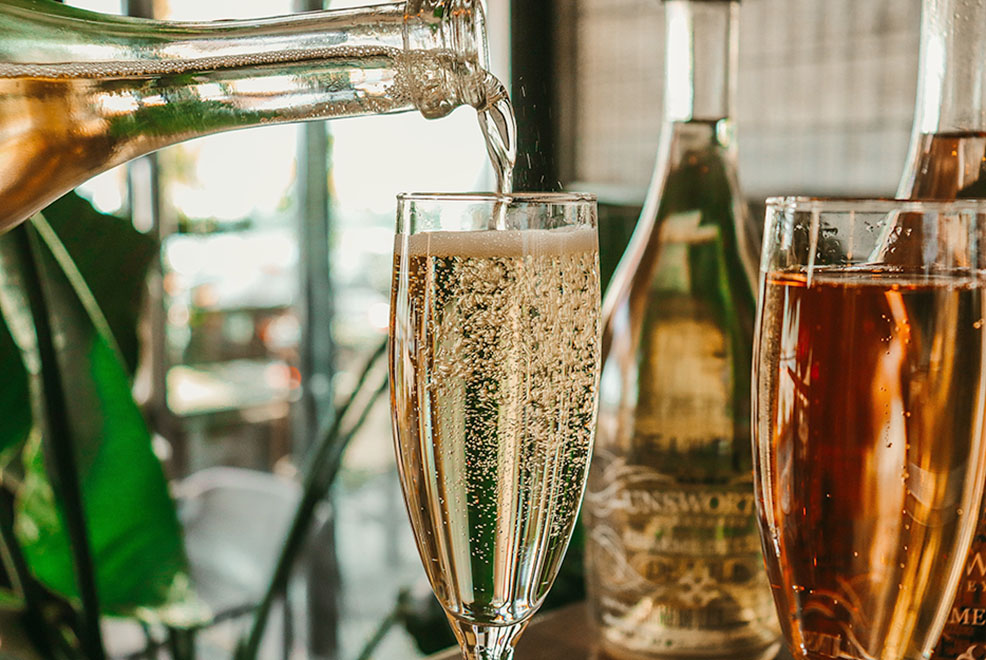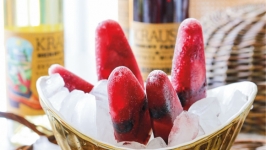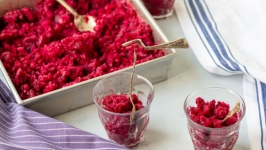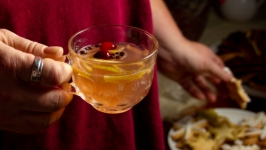A Bounty of B.C. Bubbles
Pop the cork on a bottle of bubbles and you’ve got a party started. After all, nothing says “festive” like a glass of fizz. But sparkling wines shouldn’t be reserved for celebrations. They are among the most food-friendly of wines, well matched with everything from no-name potato chips to luxurious seafood towers. They are also available at every price point, so you don’t have to wait for a milestone occasion to enjoy them. Go ahead, crack open a bottle on takeout Tuesday.
Still, sparklers are the celebratory wine of choice for good reason. The generally high acidity of the wine and pleasant prickle of the bubbles make them perfect partners for salty, fatty foods like buttery tartlets, puff-pastry bites, creamy cheeses, freshly shucked oysters and just about any kind of canapé imaginable.
Best of all, British Columbia produces terrific sparkling wines. Although the past few summers may make it hard to believe, this is still a relatively cool climate region. Those chilly night temperatures preserve a bracing acidity, while the warm days encourage complex fruit flavours to develop and our terroir contributes a refined minerality.
Sure, you can drop $70 or more (sometimes a lot more) on real French champagne, but why would you when you can pick up excellent B.C. bubbles for half the price — and support local businesses? Here are some of the best of bubbles in the province.
The charming ones
There are a few different ways to get bubbles into wine, and how it’s done directly affects the cost of the finished product, not to mention its complexity and quality.
The cheapest is to add carbon dioxide (CO2) gas directly to a tank of wine; the process is known as “injection” and generally produces a mediocre product. (Mind you, Bella Wines makes an injected fortified vermouth-style wine called Chinato that breaks all the rules.)
However, there is another method, where additional sugar and yeast are added to a tank of wine to create a secondary fermentation, with the resulting CO2 captured in the wine. This is known as the tank or Charmat method, and it’s how Italian Prosecco and German Sekt are made, along with several B.C. bubbles.
Because they are less labour intensive than wines made according to the traditional method (see below), these wines tend to be less expensive. They also tend to have softer bubbles and juicier fruit flavours. They make for excellent brunch wines and are great crowd pleasers if you are hosting a larger event.
On Vancouver Island, Charme de L’île is a proprietary style of wine made in the Charmat method. You can find versions made by Unsworth Vineyards (both in white and rosé), Averill Creek and Enrico Winery. They are light, fresh and perfectly delightful.
Evolve Cellars in Penticton is all about the bubbles, with a sparkling wine house set to open next year on the Naramata Bench. Their easygoing Evolve Cellars Effervescence is a double gold-medal winner at the All Canadian Wine Championships; its pink sibling is also a gold-medal winner. For $23, that’s a terrific deal.
Located on the Golden Mile Bench south of Oliver, Hester Creek Estate Winery is best known for its big, bold red blends, but it also produces Ti Amo, an aromatic blend of Gewürztraminer, Pinot Gris, Sémillon, Viognier and Chardonnay, a floral bouquet in a bottle.
The naturally natty
In most sparkling wines, the bubbles come from a second fermentation, but not in what’s known as ancestrale or pétillant naturel wines. In their case, the wine is bottled before the first fermentation is complete, creating wines that are bright and fresh, sometimes a bit sweet, sometimes a bit funky, usually a bit cloudy, with a soft, lazy fizz. People who love natural wines adore pét-nat.
Several B.C. producers are making pét nats, but because quantities are small and demand is big, it can be hard to find them. Look for versions from Bella Wines, Sperling Vineyards, A Sunday in August and Pamplemousse Jus.
If you can find one of these exciting wines, save it for a dinner party with your special friends.
The big bruts
Think sparkling wine and you likely think of champagne, or at least wines made according to the Champagne method, which is also known as the traditional method, or, to be fancy about it, la méthode traditionnelle.
After the wine goes through its first fermentation, it is bottled, with added sugar and yeast so it goes through a secondary fermentation in the bottle. As the bubbles form, a debris of dead yeast cells known as the “lees” accumulates. To remove the lees, the bottles are riddled — placed in special racks with their necks tilted down at an angle and regularly rotated, usually by hand, so the dead yeast cells accumulate in the neck. The neck is frozen so the sediment forms an ice plug. The bottle is opened and the pressure from the CO2 forces the plug out with minimal loss of wine. Then the bottle is topped with more wine and sometimes a bit of sugar (known as the dosage), then corked. Exceptional vintages are aged for a few years, which can add layers of rich complexity.
In general, this is how sparkling wine is made in France (it can only be called champagne if it is from the region of Champagne; otherwise it’s often called crémant) as well as Spain (where it is called cava). Many other regions, including B.C., also make traditional method sparkling wines. You’ll often notice the word Brut on the label — technically, it means “dry,” but what it usually means is quality sparkling wine made according to the traditional method.
These wines tend to have fine, long-lasting bubbles and crisp flavours of citrus, apple, pear or stone fruit, as well as hints of minerality, nuttiness and brioche (thanks to their time on the lees). They are ideal for apéritifs, celebrations or served alongside a wide range of foods.
B.C. has tons of exceptional Brut from labels as wide-ranging as Haywire Winery (The Bub) to Noble Ridge Vineyard & Winery (The One) to Unsworth Vineyards (Cuvée de L’île). Bella Wines, Fitzpatrick Family Vineyards and Summerhill Pyramid Winery all specialize in traditional method sparkling wines.
Bubbling to the top
These ones are among our favourites.
Chronos Brut: Citrus, mineral, toast. The gold medal winner at the 2022 All Canadian Wine Championships comes from Time Family of Wines and is a fitting legacy for its bubble-loving founder, the late Harry McWatters. About $35; available only at the winery.
50th Parallel Estate Blanc de Noir: Made from 100 per cent Pinot Noir grapes, this elegant wine is dry and crisp, with a hint of ripe raspberries and brioche. $100-plus; available only to club members. For details on joining the Unparalleled Club, visit 50thparallel.com.
Township 7 Seven Stars series: This winery, with locations in Langley and Naramata, is renowned for its award-winning sparkling wines. It produces several different styles; prices start at $37 and some, including the rosé Equinox and blanc de blanc and Polaris, are available only to club members. For details on how to become a member of clubSEVEN, visit township7.com.
Blue Mountain Gold Label Brut and Brut Rosé: one of the first, and still one of the best. The Brut (about $32) is all lemon and toasted brioche with a fi ne, creamy mousse; the rosé (about $40) has delightful wild strawberry notes. Available through the winery and at some retailers.









